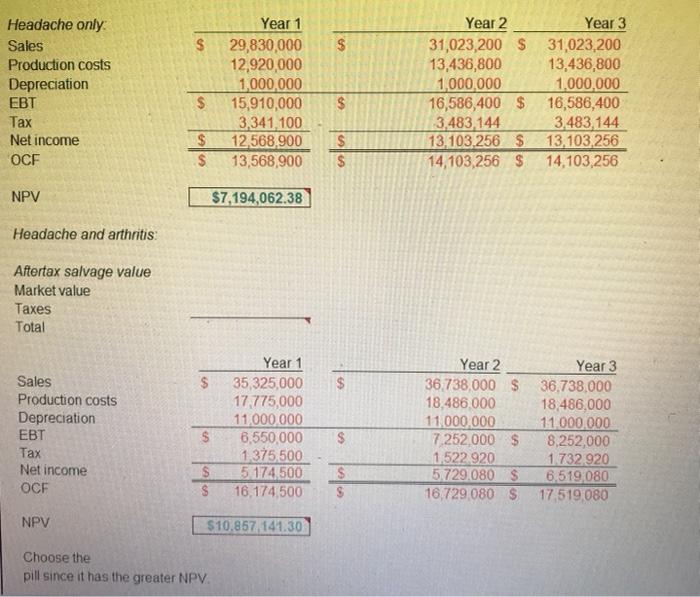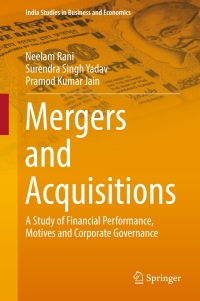Answered step by step
Verified Expert Solution
Question
1 Approved Answer
How to compute for after tax salvage value, market value, taxes and total? $ $ Headache only Sales Production costs Depreciation EBT Tax Net income
How to compute for after tax salvage value, market value, taxes and total? 

$ $ Headache only Sales Production costs Depreciation EBT Tax Net income OCF Year 1 29,830,000 12,920,000 1,000,000 15,910,000 3,341,100 12,568,900 13,568,900 Year 2 31,023,200 $ 13,436,800 1,000,000 16,586,400 $ 3,483 144 13,103,256 $ 14,103, 256 $ Year 3 31,023,200 13,436,800 1,000,000 16,586,400 3,483 144 13,103,256 14,103,256 $ $ $ $ $ $ NPV $7,194,062.38 Headache and arthritis: Aftertax salvage value Market value Taxes Total $ $ Sales Production costs Depreciation EBT Tax Net income OCE Year 1 35 325,000 17.775,000 11,000,000 6,550,000 1375500 5.174,500 16,174,500 $ Year 2 36.738,000 $ 18,486.000 11.000.000 7.252,000 $ 1,522 920 5,729.080 $ 16,729.080 $ $ Year 3 36.738.000 18,486,000 11.000.000 8,252,000 1.732920 6.519,080 17,519.080 $ $ $ S NPV $10,857 141.30 Choose the pill since it has the greater NPV. Project Analysis and Inflation After extensive medical and marketing research, Pill, Inc., believes it can penetrate the pain reliever market. It is considering two alternative products. The first is to produce a medication for headache pain. The second is a pill for headache and arthritis pain. Both products would be introduced at a price of $7.85 per package in real terms. The headache-only medication is projected to sell 3.8 million packages a year, while the headache and arthritis remedy would sell 4.5 million packages a year. Cash costs of production in the first year are expected to be $3.40 per package in real terms for the headache-only brand. Production costs are expected to be $3.95 in real terms for the headache and arthritis pill. All prices and costs are expected to rise at the general inflation rate of 4 percent. Either product requires further investment. The headache-only pill could be produced using equipment costing $30 million. That equipment would last three years and have no resale value. The machinery required to produce the broader remedy would cost $34 million and last three years. The firm expects that equipment to have a $1 million resale value (in real terms) at the end of Year 3. The company uses straight-line depreciation. The firm faces a corporate tax rate of 21 percent and believes that the appropriate real discount rate is 6 percent. Which pain reliever should the firm produce? $ $ Headache only Sales Production costs Depreciation EBT Tax Net income OCF Year 1 29,830,000 12,920,000 1,000,000 15,910,000 3,341,100 12,568,900 13,568,900 Year 2 31,023,200 $ 13,436,800 1,000,000 16,586,400 $ 3,483 144 13,103,256 $ 14,103, 256 $ Year 3 31,023,200 13,436,800 1,000,000 16,586,400 3,483 144 13,103,256 14,103,256 $ $ $ $ $ $ NPV $7,194,062.38 Headache and arthritis: Aftertax salvage value Market value Taxes Total $ $ Sales Production costs Depreciation EBT Tax Net income OCE Year 1 35 325,000 17.775,000 11,000,000 6,550,000 1375500 5.174,500 16,174,500 $ Year 2 36.738,000 $ 18,486.000 11.000.000 7.252,000 $ 1,522 920 5,729.080 $ 16,729.080 $ $ Year 3 36.738.000 18,486,000 11.000.000 8,252,000 1.732920 6.519,080 17,519.080 $ $ $ S NPV $10,857 141.30 Choose the pill since it has the greater NPV. Project Analysis and Inflation After extensive medical and marketing research, Pill, Inc., believes it can penetrate the pain reliever market. It is considering two alternative products. The first is to produce a medication for headache pain. The second is a pill for headache and arthritis pain. Both products would be introduced at a price of $7.85 per package in real terms. The headache-only medication is projected to sell 3.8 million packages a year, while the headache and arthritis remedy would sell 4.5 million packages a year. Cash costs of production in the first year are expected to be $3.40 per package in real terms for the headache-only brand. Production costs are expected to be $3.95 in real terms for the headache and arthritis pill. All prices and costs are expected to rise at the general inflation rate of 4 percent. Either product requires further investment. The headache-only pill could be produced using equipment costing $30 million. That equipment would last three years and have no resale value. The machinery required to produce the broader remedy would cost $34 million and last three years. The firm expects that equipment to have a $1 million resale value (in real terms) at the end of Year 3. The company uses straight-line depreciation. The firm faces a corporate tax rate of 21 percent and believes that the appropriate real discount rate is 6 percent. Which pain reliever should the firm produce 

Step by Step Solution
There are 3 Steps involved in it
Step: 1

Get Instant Access to Expert-Tailored Solutions
See step-by-step solutions with expert insights and AI powered tools for academic success
Step: 2

Step: 3

Ace Your Homework with AI
Get the answers you need in no time with our AI-driven, step-by-step assistance
Get Started


